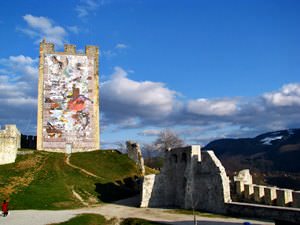 The third-largest city of Slovenia, Celje, has been known since ancient times. In the Middle Ages the city was the center of the only Slovenian state that had managed to maintain the complete independence (Celje County). Therefore, the count's symbol (three stars) has become the emblem of the city and a part of the State Emblem.
The third-largest city of Slovenia, Celje, has been known since ancient times. In the Middle Ages the city was the center of the only Slovenian state that had managed to maintain the complete independence (Celje County). Therefore, the count's symbol (three stars) has become the emblem of the city and a part of the State Emblem.
The old count's castle, which has preserved here, is one of the city's major attractions. Tourists will find much interesting in visiting Town Hall built in 1830, Bridge the Capuchins, Count's Palace and Spodni grad (bottom castle), as well as Church of St. Cecilia and St. Mary (built in 1310). Here have remained many other old buildings that make even a walk in the streets of the city truly exciting.
The oldest building in the city is St. Daniil’s Monastery built in the 14th century. In the Middle Ages, the monastery was considered as a central building in the city. Today, it is located in its western part. The temple is a vivid example of the Gothic architecture. It has preserved beautiful interior elements finished in the 16th century. Its visitors can admire an ornate ceiling and aisles. When it was reconstructed in the 18th century, St. Francis’s Chapel was built in it. Today, it is an incomparable supplement to the general architectural complex.
 Another unusual architectural monument is the Celje House that you can see when walking through the historic district. The beautiful stone house was built at the beginning of the 20th century. It was projected by Peter Brang, a famous architect from Vienna. The construction looks like it was built in the Middle Ages. In the period of the First World War, it has managed to survive in its initial form.
Another unusual architectural monument is the Celje House that you can see when walking through the historic district. The beautiful stone house was built at the beginning of the 20th century. It was projected by Peter Brang, a famous architect from Vienna. The construction looks like it was built in the Middle Ages. In the period of the First World War, it has managed to survive in its initial form.
In the historic district of Celje, there is the preserved water tower built in the 15th century. Initially, there were four defense towers but only one has been preserved over 500 years later. After viewing the tower, you should certainly pay your attention to the St. Daniel Church. It is quite small and was built on the ruins of the destroyed church of the 14th century. In 2006, the beautiful church with a tiled roof and high narrow windows has gained a status of the cathedral church.
 St. Joseph’s Church is very symbolic and unusual from the architectural point of view. You can recognize it by its big stone tower. The church was built in the 17th century and is a vivid example of the baroque style. In the 17th century, the city saw the plague epidemic that took the lives of thousands of citizens. It was decided to build the church to rescue the city from the plague.
St. Joseph’s Church is very symbolic and unusual from the architectural point of view. You can recognize it by its big stone tower. The church was built in the 17th century and is a vivid example of the baroque style. In the 17th century, the city saw the plague epidemic that took the lives of thousands of citizens. It was decided to build the church to rescue the city from the plague.
The most visited cultural center of Celje is the Posavje Museum that occupies the beautiful old castle. The Posavje Museum collection is quite diverse. Here, you can see old weapons, pieces of art, unique accessories, and ancient books. Most of the exhibits are devoted to multiple wars Slovenia has seen for the last hundred years.




